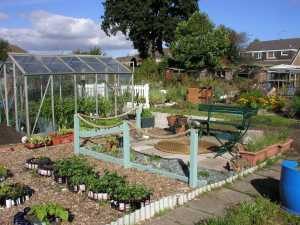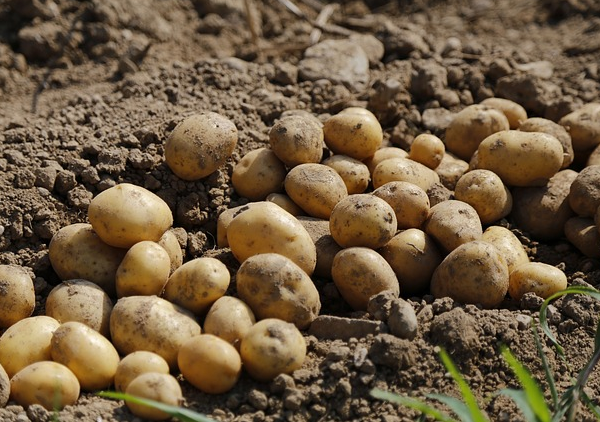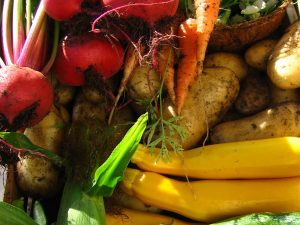October is really the last of the hectic months on the vegetable plot. There’s little to sow and plant but still a fair amount to harvest and store away to eat through winter. This is the month when the first frosts usually arrive so killing off all but the hardy plants.
Sowing & planting in October on the vegetable plot

An allotment in October sunshine.
Over-wintered broad beans can go in from the middle of the month to provide an early crop next year. Whilst they’re very hardy, they don’t like sitting in water so on heavy soils they can be a gamble and you may prefer to just sow early on next year. The last sowing of beet leaf spinach can be made early in the month and you may be able to just fit in some Chinese cabbage.
October is the last chance for planting out Japanese onion sets. These are hardy, short-daylight onions so will bulb up about a month earlier next year than the normal onions but they don’t store as well so go for a smaller quantity rather than larger. It’s worth protecting them with a cloche or netting until well established as they hold a magnetic attraction for pigeons who seem to delight in pulling them from the ground and throwing them to the side.
You can plant out garlic in October but generally it’s a November job. However, if the weather turns nasty then you’ll have one less task to do outside.

Plant over-wintered broad beans.
General garden tasks for October
There’s not a lot to do except for keeping weeds in check with the established crops. If you’ve got Brussels Sprouts it’s worth checking they’re firm in the ground as wind-rock breaks the tiny hairs on the roots that take in the nutrients. Earthing up a few inches around the stems and treading in or staking should be enough. In very windy areas a wind break can save the day.
If the leaves are looking a little yellow, apply a high nitrogen liquid feed around each plant and this should perk them up enough to ensure good firm sprouts for Christmas. With other brassicas, remove any yellowed leaves as they are of no use to the plant and will encourage botrytis to develop.
If you’ve a green manure crop like mustard mature, now is the time to dig it in. Generally I find mustard produces a lot of foliage which can be cut with shears about a foot (30cm) off the ground. Compost the cut foliage and dig in the rest.
As ground becomes vacant, you can dig it over, With heavy clay soils just leave the clods unbroken and the freezing / thawing action of winter weather will break them up, giving you a fine tilth to work with in the spring.
Spread manure or compost over the surface and leave for the worms to drag down into the ground or lime if appropriate.

Make sure Brussels sprouts are firm.
Digging over the plot
October and November are good months for serious digging. The deeper the fertile soil, the better crops that can be had. Double digging where you remove a trench and then break up the sub-soil with a fork prior to adding a good layer of manure or compost and then place the soil from the next trench on top will greatly improve your soil.
With light deep soils that don’t benefit from annual digging, sow a green manure like field beans that will hold the nutrients in the soil over winter until spring when you dig them in to add both humus and nutrients
Now is the time to concentrate on your compost making. The last of the bulk foliage should be available to build a proper heap rather than a waste pile. Emptying one bin into another, layering with lime and nitrogen rich manure as it builds, will ensure decomposition gets off to a good start.
Consider where you intend to plant your runner beans and start a bean trench, digging it out and lining with newspapers (six sheets thick) before adding compostable kitchen waste, lawn clippings etc and covering with soil.

Mustard green manure.
Fruit
This is a good month to prune your blackcurrants, redcurrants and gooseberries. Yourraspberries and blackberries need cutting back, tying in etc and these early winter months are ideal for planting out new stock. Make sure the ground is well prepared and add a good 500gr of bonemeal per plant to the base of the planting hole, forked in. This will slowly release its nitrogen over the next year or two giving stronger plants earlier
October greenhouse tasks
See here for greenhouse & polytunnel tasks in October.

Time to prune blackcurrants.
Harvest
Any remaining maincrop potatoes should be ready. When the haulm (leaves) starts dying back you cut it off and leave the potatoes for a couple of weeks. This will make the skins set and hopefully prevent any stray potato blight spores from the haulm infecting your tubers. Wait for a sunny dry day and dig up the potatoes, brushing off excess soil and letting them dry off before storing in hessian or paper sacks in a frost free, dark shed.
The last of the beans should be picked now, compost the foliage but leaving the roots with their nitrogen full nodules in the soil will act as a fertiliser.
Maincrop carrots should be dug up to be stored in sand or peat through the winter but leave the parsnips in the ground as they’ll be sweeter after a frost.

Time to harvest salsify.
Drumhead cabbages that are ready should be harvested. They’ll keep remarkably well in a frost-free shed but be aware that a slug that may be lurking under the leaves. Sprinkling the outside with salt will deter them from eating away through the winter.
You can harvest Salsify and Scorzonera. Salsify is also known as the ‘vegetable oyster’ and, properly cooked, salsify is a gourmet’s delight of a vegetable.
Any green tomatoes on outdoor plants can come in now before the frost gets them. You can make a green tomato chutney or ripen them up indoors.
Green tomatoes will actually store quite well in cool conditions and slowly ripen or you can hasten the ripening process by popping them in a tray in a sunny windowsill with a ripe banana.

Storing carrots in sand.
Thanks to John Harrison of Allotment & Gardens for information.
You can get John’s book Vegetable Growing Month-by-Month here.


